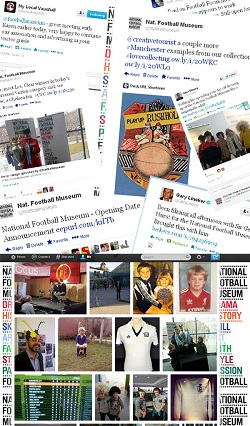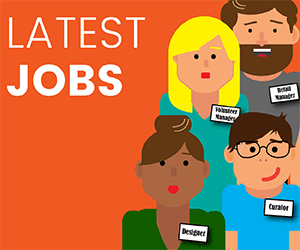However, we soon realised that while everybody’s talking about ‘doing it’, not everyone is and those who are have only been doing so for a relatively short time. More importantly (and more relevantly to this article), we were doing it while we had no objects, no displays and no museum. So, in a nutshell, the answer to ‘why us’, was ‘because you may not be the experts but maybe people can learn from what you did (or didn’t) do’.
So – Social Media Through Thick and Thin. To set this in context you need to know something about the history of the National Football Museum.
The Museum opened in Preston in 2001, with the help of Heritage Lottery Funding. It was funded by DCMS and the Football Foundation until 2009 and, during that time built a solid local reputation and a loyal audience from those visiting Preston North End on match days (the museum was situated at PNE’s ground – the oldest surviving pitch in continuous use, for those who are interested in that kind of stuff). When funding came to an end in 2010, Manchester City Council funded a move to the Urbis building in Manchester. The Preston site closed in April 2010 and a new National Football Museum, (project funded by ERDF) opened in July 2012. With a closed period of nearly two and a half years, some negativity around closing Preston and closing Urbis (the previous inhabitants of the building had built a successful contemporary exhibitions programme), and ongoing uncertainty as to our opening date (we only found four months beforehand), these were interesting times for the marketing and communications department.
We could of course have said nothing and got quietly on with all the other things that came our way – focus groups, new brand identity, new website, marketing plans, etc etc . However we wanted to let people know about this great opportunity for the museum and for Manchester -improving access to the collection; opening up a landmark building to a much wider sector of the public; contributing to Manchester’s tourism and football heritage and of course creating a world class football destination. We also wanted to continue engaging those who’d been with us since the Preston days, shape perceptions of the project (in other words try and deal with some of that negativity), recognise some of the new audiences and stakeholders out there and communicate our new brand values. So, how could we talk to all these people on a regular basis about a museum with nothing in it and with no idea as to how it was going to look? Thank goodness social media happened.

Our social media strategy, hastily scribbled on a sheet of A4 one day was quite simply:
- Raise awareness
- Give people a ‘behind the scenes’ glimpse
- Build links
- Learn and share from like minded organisations
- Engage with ambassadors including media
- Show we are ‘in touch’ with the wider world
- Show we are ‘human’.
Our feeling was that we didn’t need a separate ‘social media’ strategy – it quite simply became part of our overall communications strategy with the same messages.
Twitter immediately felt like the right tool to use. It somehow felt more ‘instant’ and conversational. Our Twitter account @footballmuseum started prior to the museum closing in Preston; right from those early beginnings we knew that a human, approachable tone of voice was important. We knew we’d got it right when one of those Preston visitors, who we’d kept chatting to, came to the museum in Manchester with his two boys who posted a great little YouTube video of their visit. That’s the kind of engagement social media can bring you.

In Manchester conversations continued and new ones started. The World Cup came…and went. We were closed but it was a great opportunity for us to post pictures of the 1966 world cup winning football and Jules Rimet trophy (both in our collection and for you non football fans, that was the year England won the world cup). Donations of new objects came in – again a great chance to post a photo. Christmas, Easter – let’s give away something in a competition – doesn’t have to be much…maybe a Roy of the Rovers annual. It all helped build awareness and keep us relevant.
The critics were still occasionally rumbling away in the background. This is the nature of social media. You just need to recognise a legitimate critical question from a ‘trolly’ one. It’s fine to disagree – just be polite. You’ll often find people come to your defence. Turn it round; ask the critics for their suggestions – always be conversational, not confrontational.
As the new kids on the block in the wonderful city of Manchester, we also wanted to be a good new neighbour. We said hello to other museums, we engaged with the media, especially the football media and we also used social media as a means to recruit local people for focus groups and research. So, suggest someone visits another museum; give Dan Walker (Football Focus host for those not in the know) a pun for his twitter feed; get to know your tourism agency.
We also found it helped us introduce our new brand. It felt like a natural fit – we’re very much about personal experiences, stories and sharing. We commissioned a holding website and integrated social media by asking people to ‘like us’, ‘join the crowd’ and to submit their own football related doodles and stories for our opening countdown.
Whatever we did we always kept in mind our own ‘voice’. We were (and are) always happy to comment, ask and highlight things but we never give our opinion –that way disaster could lie. Know who you are and be true to your brand and your organisation’s values. We aren’t pundits and we aren’t statisticians -see the Football League or Alan Hansen if that’s what you’re after.
So, what did we learn and what’s for the future? Well, we realised Twitter was right for us during the closed period, but, since we opened, Facebook which is more content driven, has begun to take off. We used social media to converse with those who liked us and those who didn’t and it helped create a feel-good atmosphere. We made new friends and neighbours, while staying friends with some old ones and it helped us communicate our values and brand. Most importantly we kept the conversation going over two and a half years! Facebook continues to grow and we’re looking at how we can incorporate competitions. We want to improve social media interaction via our website and we’re keeping an eye on other social media by continually reviewing what works for us (and what doesn’t). Finally we’ve realised that we need to push social media off line too – staff uniforms, advertising, messaging around the venue.
To summarise:
- Use the right social media tool for your organisation
- Be human; find your own voice
- Don’t spread yourself too thinly but remember to experiment – you’ll soon know whether it’s the right one for you
- Don’t be afraid to speak to your critics…but beware the trolls
- You don’t always have to start the conversations – joining in is just as important
- Take people with you on your journey
- Keep it relevant to your core ideals – promote the collection, promote your subject and remember you don’t have to be ‘the expert’
- Content is king – people love pictures/videos – it increases engagement by up to seven times!
- Thank your followers
- Use your physical space (uniforms, building etc) to promote social media
So, while we’re not the experts, with a little thought, you, like us, can do all the things the experts tell you, you need to do. Happy Tweeting, Liking, Pinteresting and Instagramming!
Back to top




